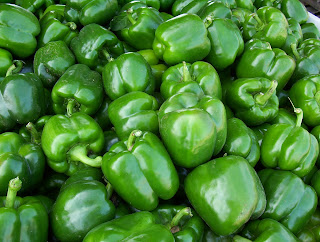Farm Ingenuity
The last time a farmer friend was at Elmwood Stock
Farm, we were discussing how farmers are in the “material handling business.”
Whether it is making hay for winter-feeding to livestock or packing produce
crates for market, each farmer has to develop a system to move stuff
around. For us, it’s not just about
efficiency, but food safety, worker comfort, scheduling, flexibility with
varied climatic conditions, and equipment capabilities - it all comes into
play. By definition, no two days are alike at the farm. The pick list for the
produce is different every time. The produce itself varies depending on the
weather, and must mesh with a bunch of other produce coming in from different
fields. We must be prepared with enough trays, totes, buckets, tubs, boxes,
carts, racks, dollies, passive conveyors, grading equipment, walk-in coolers,
wash sinks, etc. Each morning the crew makes a plan on which produce gets
picked and in what order. There needs
to be an efficient system in place to be sure it all gets done in time to pack
your share and put it on the truck at the appointed time.
Our packing shed, where all the produce comes in
from the field to be washed and/or packed is a good example of the “farm
ingenuity” needed in order to handle these materials (fresh produce and water). All the leafy greens, peppers, cucumbers, beets, lettuces
and the like must be washed to meet our quality standards and be appealing to
you. We do not offer any of our produce
as ready-to-eat and encourage you to always wash any produce you get in your
CSA share, at the supermarket, or at a farmers market. But many of our produce items are double
rinsed. We use potable water to wash
field dust off of the produce and allow the cold water temperature to help
lower the temperature of the item as it comes in hot from the field – the first
step in proper post-harvest handling.
The packing shed is set up with materials, equipment, and supplies in
their appropriate spot adjacent to the wash lines. To supply water to the
sinks, a water line is attached to a frost-free hydrant, and then runs up the
wall along the ceiling of the shed over the sinks. The waterline is cut to the
appropriate length, configured with T’s and L’s to provide line drops into each
of the wash sinks, and a good brass shut off valve acts as the on/off allowing
the supply water to be pulled as needed to the basins for fresh water.
Another example of farm ingenuity is managing the
1200 pound round bales of hay. The fields are cut with a 9 foot wide mower, the
clippings are raked into windrows with a 20 foot wide rake that folds up for
transport, and baled with an implement that rolls it up and wraps string around
it to hold it together. At this point the bales are scattered about the field.
Rather than pull wagons out into the field, un-hook the tractor to use the
front end loader to hoist them onto the wagon, then re-hook the wagons, then
un-hook at the hay yard to unload, we engineered a way to move four large bales
at a time, without getting on and off the tractor. Two steel spears, actually
four foot long spikes, are welded to a rugged steel frame that can quickly be
attached to the front end loader on the front and two spears are welded to
rugged steel that quickly attaches to the lifts on the back of the same tractor
to carry four bales at one time (over 2 tons of freshly baled hay). This way we
can drive thru the field spearing the bales with the spikes, then drive to the
hay yard and drop two at a time in neat rows. At feeding time in the winter, a
separate implement, attached to the tractor, pinches each bale between two arms
in the center of the roll. When the tractor gets to the field, it moves along unrolling
the bale across the field so all the animals have access to hay and can eat at
the same time. This also prevents the animals from harming the ground by
compacting the soil if too many are crowded into a small area around the bale
to eat.
These are just a couple of examples of the many systems
needed to allow a diversified farm to function well. At Elmwood Stock Farm, we use a combination of traditional
methods combined with modern technology with the intent to bring some efficiency
to our “material handling business.”
In Your Share
Green
Beans- organic
Eggplant
Onions
-organic
Bell Peppers
Fingerling Potatoes - organic
Tomatoes
– organic
Sweet
Basil-organic
Swiss Chard – organic
Hot Chile
Peppers - organic
Recipes to Enjoy
Chicken Enchiladas, our thanks to a CSA member who shared
one of her family’s favorites using the delicious red bell peppers, now in
season.
2 red bell peppers, seeded
3 oz. cream cheese (reduced fat, fine)
3/4 C picanti sauce
1/2 tsp salt
3 C chicken, cooked and chopped or
shredded
1/2 Cgreen onions, sliced
8 flour tortillas
1 C shredded cheese
Sauce: Puree 1 pepper, 3 oz. cream cheese
and salt until smooth. Stir in picanti
sauce.
Filling:
Stir together chicken, the other pepper diced, onions and half of the
above sauce. Spoon filling onto tortilla,
roll and place seam side down in baking dish (sprayed with Pam). Spoon reserved sauce over rolled
tortillas. Cover loosely with foil. Bake 20 minutes at 350°F or until hot. Remove foil, sprinkle with cheese. Serve on a bed of shredded lettuce, with black olives and sour
cream, if desired.
Orecchiette with Ricotta and Chard Pan
Sauce, thanks to a CSA
member for sharing this tasty recipe from Better Homes and Gardens magazine.
1 large bunch organic Swiss chard
¾ lb dried orecciette
2 T extra virgin olive oil
2 T butter
crushed red pepper, optional
2 oz ricotta salata, asiago, or pecorino
cheese, freshly grated
¼ C fresh, whole-milk ricotta cheese
sea salt and cracked black pepper
freshly grated ricotta salata, asiago or
pecorino cheese
Bring large pot of generously salted water
to boiling. Separate chard stems from leaves;
cut both into bite-sized pieces. Add
orecchiette to boiling water. Set timer
for 10 minutes.
Meanwhile, for pan sauce, in large
skillet, heat oil over medium-high heat.
Add chard stems; cook 3 to 5 minutes, until crisp-tender.
After 10 minutes, add chard leaves to
cooked pasta; cook 2 minutes more.
Drain, reserving about ¼ C of cooking liquid. Return pasta and chard to pot; place over lowest heat
setting. Add chard stems and any
residual oil to pasta, along with butter, crushed red pepper, and reserved
cooking liquid. Grate in ricotta
salata; toss. Season with pepper and
nutmeg. Divide among bowls. Top each with about 1 T ricotta. Add sea salt , pepper and additional ricotta
salata to taste. Makes 4 servings.
Roasted Eggplant and Yogurt Spread with
Onions and Olives, thanks
to a CSA member for sharing this easy recipe.
She adapted it from an original found online.
1 medium to large eggplant
6 T Kalamata olives, chopped
2 cloves of garlic, minced or finely
chopped
1 ½ T fresh basil, de-stemmed and coarsely
chopped
½ small onion, finely chopped
½ tsp favorite seasoning mixture
8-12 oz Greek yogurt
Roast eggplant whole on a baking sheet in
the oven for about 50 minutes to 1 hour at 400°F.
Meanwhile, prepare and mix the olives,
garlic, basil, onion and seasonings together in a bowl.
When the eggplant has cooled enough to
handle, cut off the stem end, slit the skin and scoop out all of the eggplant
pulp. Mix the pulp in with the other
ingredients. Start adding the yogurt
and stirring it in until you have a spreadable consistency.
Refrigerate several hours or overnight to
allow flavors to meld. Serve on
flatbread or with favorite crackers or bread as a dip.
Margaret’s Chile Sauce from Maggie Green’s Kentucky Fresh cookbook. Enjoy on meatloaf, beans or scrambled eggs. Makes 5 pint jars.
4 ½ to 5 lb tomatoes, finely chopped (12 C
chopped)
1 ½ C finely chopped onion
3 red or green bell peppers, seeded and
finely chopped
3 C finely chopped celery
2/3 C light brown sugar
1 T celery salt
2 tsp cinnamon
2 tsp dry mustard
½ tsp freshly grated nutmeg
2 T salt
1 C apple cider vinegar
In a large Dutch oven, mix all the
ingredients except the vinegar. Bring
to a boil, reduce to a simmer, and cook for 1 and ½ hours. Stir in the vinegar and simmer for 45 minutes
longer, stirring frequently. Pour the
hot tomato mixture into sterilized jars.
Put on the sterilized lids and rings.
Process in a boiling water canner for 15 minutes. Carefully remove the
jars and place them on a towel to cool, leaving at least 1 inch space between
the jars, let sit for 12-24 hours. The
lids should seal down tight during the cooling process; do not push down on the
lids until after completely cooled and sealed.
Any lids that do not seal should be refrigerated and eaten soon.




